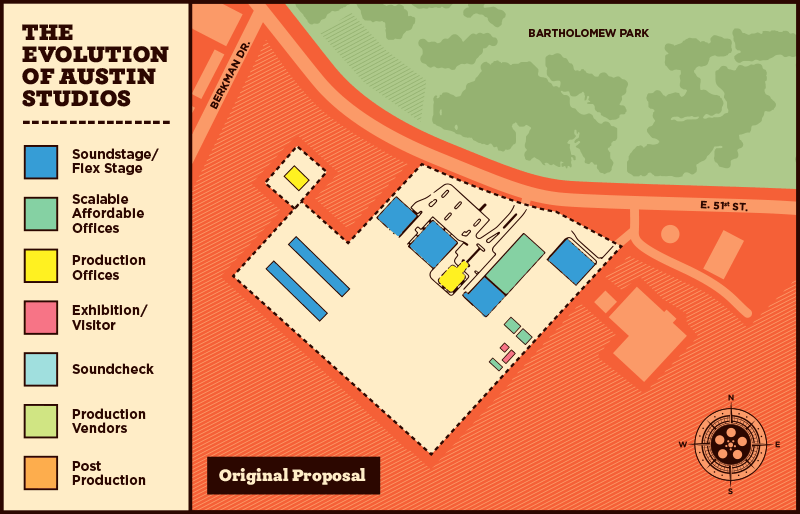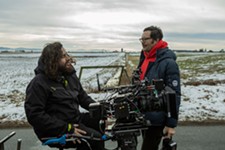20 Years of Austin Studios
More than just soundstages: Looking back on the unique success of Austin Studios
By Richard Whittaker, Fri., Feb. 28, 2020
It's a memorable moment in film history: Sandra Bullock strutting on high heels out of an aircraft hangar in Miss Congeniality, Los Lobos' cover of "Mustang Sally" blaring. But it may not be famous for the reason you think. It's the moment when Austin Studios, the filmmaking facility run by Austin Film Society for the city of Austin, became a working studio. Not just that, but a unique entity, run not just as a business but as a hub for the local filmmaking creative class.
Multiple major TV shows, hundreds of commercials, and dozens of feature films – some quite surprising – have been produced there. The end of Spike Lee's 25th Hour, when Edward Norton gets on the bus? They were filming out of Austin Studios. When Sutton and Rebecca were floating in the pool in The Lying Game? Austin Studios. The moment in the Coen brothers remake of True Grit, when Rooster Cogburn shoots the dying horse? "They're on Stage 3 at that point," said Austin Film Society CEO Rebecca Campbell. She laughed. "Talk about deconstructing movie magic."
After 20 years of operations, Austin Studios seems like it's been there forever, but the plan to create a permanent moviemaking home goes back much further. According to Gary Bond, former executive director of the Austin Film Commission, people had talked about building a film studio in Austin, but "it was a pipe dream that existed since I started doing this in the early Eighties."
If You Build It, They Might Come
Campbell found herself in the middle of this discussion in 1998, barely a year out of her MFA in Film & Video Production at UT-Austin and recently hired as AFS's part-time executive director. She said, "All these amazing plates were spinning. We're giving grants to filmmakers, we're showing free films, we have an apprenticeship program, and people are getting trained [but] there's no foundation under it." So the team draws up its first, incredibly ambitious strategic plan. The only problem was that there was nowhere to implement it.
And then the airport closed.
It was one of the biggest real estate deals in Austin history. In 1991, the federal Base Realignment and Closure Commission decided that Bergstrom Air Force Base in southeast Travis County was surplus to requirements and would be decommissioned. This was great news for the city of Austin, which was struggling with the fact that its overcrowded commercial airport, Robert Mueller Municipal, was in the worst possible location – slap bang in the middle of the city, with nowhere to expand. Suddenly, a solution to the capacity problem appeared. Bergstrom was actually located on city-owned land on long-term loan to the feds. They moved out, leaving the city with purpose-built runways and plenty of space to build a passenger terminal. Long story short, in May 1999, Bergstrom airbase becomes Austin Bergstrom International Airport, while Mueller saw its last commercial flight and became the future Mueller development – all except for one corner.
In the original masterplan, a series of hangars just off of East 51st was earmarked for state offices. Yet that plan fell through and suddenly there was 20 acres outside of the proposed Mueller development with no set purpose. For the long-term proponents of a local studio this was beyond fortuitous. While Austin had a film industry – a mix of small indie pics and visiting movies-of-the-week – what it didn't have was studio space, and those hangars were ripe for conversion. "In those days," Bond said, "column-free space was golden. Half of my job was finding people warehouses to convert into jury-rigged soundstages, freezers were used in South Austin. So this seemed like such a good idea."
However, the only problem with good ideas is that everyone seems to have one. Bond recounted the first time he and AFS founder Richard Linklater met with then-mayor Kirk Watson and pitched him the studio plan. "He said, 'You've got a real good idea, but let me show you.' Then he lifted an eight-inch stack of good ideas that other people had. He said, 'The object is to get your piece of paper on the top here.'"
Yet Watson had one requirement before anything else could happen – the studio had to be run by a nonprofit. Luckily, Linklater knew one. At that time, AFS was based out of his Detour Productions offices, and Campbell recalled the filmmaker's pitch. "He comes into my cubicle. 'What do you think? Do you think AFS would want to do this?' 'Hell, yes.'"
Still, on the surface it was a risky plan. Founded in 1985, AFS had become a key part of the local film scene – both through organizing screenings and with support for projects in production through the AFS Grants (now the Texas Filmmaker Grant program). Yet they had no experience running a studio or undertaking this scale of construction project. Campbell said, "That first meeting with [Assistant City Manager for Aviation] Jim Smith, him and his staff were asking, 'What do you know about real estate?' and we were saying, 'We know film, this will work.'"
So how did AFS get to the top of that huge stack of paperwork in Watson's office? According to Bond, it was all down to legwork. "[AFS] went to the neighborhoods, met with the neighborhood associations." After all, the community had been promised that the hangars would be razed, so AFS deployed the big guns to undertake outreach, like Linklater and AFS and The Austin Chronicle co-founder Louis Black. "I believe Sandra Bullock may have made a meeting or two. At any rate, the neighborhood was persuaded."
It didn't hurt that the basic model of using hangars as studios was a proven model. In fact, AFS could point at a perfect example right along the street: Robert Rodriguez was already using old state-owned hangars as his Troublemaker Studios facility. Campbell said, "When the skeptics said, 'How can this possibly work?' then we could point to Troublemaker." It actually meant Troublemaker had extra space available in an adjoining facility – in fact, there was a path between the two studios – and in the last 20 years Troublemaker has been the single biggest historic tenant at Austin Studios, and Campbell credited Troublemaker vice president and co-owner Elizabeth Avellán for helping them dot some important I's and cross some vital T's. Per Campbell, "She and her then-assistant spent a couple of late nights getting this proposal ready."
After all that work and with the support of the Mueller Neighborhood Coalition, on Feb. 3, 2000, Council voted unanimously to instruct staff to begin negotiations with AFS about turning those 20 acres into "a multimedia support facility." Nine months later, Austin Studios officially opened, paying a nominal rent of $100 a year. "It was kismet," said Campbell. "When obstacles melt away like that it's meant to be, and obviously it was meant to be because here we are, 20 years later, being able to look 20 years ahead."
The Dog That Caught the Car
Yet that handover was really where the tough work began of turning an old airport into a little slice of Hollywood. Luckily, Miss Congeniality was already filming in the hangars: the crew had leased a trailer as a production office for the duration of the shoot, and simply transferred the lease to AFS so at least they'd have some office space while they solved all the other problems, like converting those hangars. While they look like soundstages, Bond said, "They're not the same." Between rainproofing, soundproofing, and getting rid of the pigeons, "it was a learning curve for everybody involved to make those things work as anything you could promote as being a stage, not just a warehouse retrofit."
Fortunately, the response from the industry was immediate and positive. Gear rental firm Chapman Leonard Studio Equipment moved in quickly, as did transport firm Film Fleet, and prop warehouse Miscellaneous Rentals, meaning out-of-town-productions had easy access to the kit they needed. Pretty much the instant Miss Congeniality moved out, high school comedy The New Guy moved in and so Austin Studios had its first real tenant of many. Early on, Bond took a trip to Los Angeles to promote Austin Studios at trade shows like LocationEXPO, and he took a manila envelope filled with spec sheets with him. "People were going nuts," he said. "It was like I was dealing those little pieces of paper instead of handing them out."
Bond added, "Everything fell into place like a tumbler in a lock. It was exactly what the city needed. It was perfect for the time, and it's evolved with the time."
Won't You Be My Neighbor?
But the studio was only 20 acres out of 700 from the old airport, and the rest was about to spend the next two decades as a construction zone. When Catellus Development Corp. came onboard in 2002 to implement the Mueller master plan – turning all those designs and all that brownfield into houses and stores – Austin Studios was already up and running, and that meant Mueller had a neighbor with very specific needs. However, according to Catellus Executive Vice President Greg Weaver, it's always been a strong collaborative relationship. He said, "We work closely with Rebecca Campbell and her team to work out what do we do at the end of the day to incorporate it, knowing that we're all going to live together long term."
It hasn't hurt, he added, that the same key people – himself, Campbell, and City of Austin Redevelopment Project Manager Pam Hefner – have all stayed involved with the project. It also didn't hurt that Catellus appreciated the need to work with AFS even before the development firm broke ground. During the bidding process to take on the master plan, Campbell said, "They were coming to see us to ask, 'Will you support us becoming the developer, because we recognize that you're setting the tone for this development as something that's going to support Austin's creative class.'"
It's been a mutually beneficial relationship with some unexpected benefits (True Grit even used the spoil piles from construction to fill in for the rough terrain of New Mexico). Yet it's shifted over time because the shape of the studio has changed dramatically, swapping land with Catellus to the west and south as it expanded to the east. For example, in 2008 the studio handed over what used to be maintenance hangars to Catellus so they could build the new market district and the Mueller H-E-B, getting a large stretch of tarmac in exchange as backlot. This meant the development was filling in right next to the studio, so Catellus built a fence designed to give productions privacy. At the same time, Weaver said, "The film studio said, 'Hey, we'd love to be able to walk over to the H-E-B,' and rather than having to walk all the way around the fence, we put a gate in." It seems like a small detail, said Weaver, "That's an example of, over the years, just working together to say, 'Hey, here's our needs, here's your needs, and let's figure out ways to design all this together as great neighbors.'"
The H-E-B swap wasn't the only big change. In 2013, Austin Studios took over the old National Guard Armory to the east, and because the lease with the city is for 20 acres they handed over part of their backlot to Catellus. However, like 2000, when Miss Congeniality was warming up the studio before AFS moved in, they already had a movie shooting in the armory, JFK assassination drama Parkland. Studio manager Chris Engberg said, "We were supposed to take the building in September of 2012, and then negotiations kept pushing back. So Parkland moved in in December, and we worked with them to do repairs on the building before we officially took it in March."
Having a tenant wasn't the only echo of the original studio opening. The facility was, to be kind, not in great shape. "It was dilapidated," said Engberg. "The stage itself, when you looked up you could see the sky."
But seven years and a massive renovation (including around $70,000 in roof repairs alone) later, the old armory is now Stages 6 and 7, plus the shell of the new Creative Media Center. That's the future of Austin Studios, and one that newly-hired studio director Martin Jones will help forge. An industry veteran, he sees the CMC as a tool for balancing and broadening the studio's portfolio. "It's screaming post-production, immersive storytelling, next-generation media, branding, advertising. Those are the kind of clients that will thrive in that space."
Adding that space is enormously exciting for Engberg because it's so flexible. When he joined AFS in 2012 from the now-defunct Action Figures stage on Cesar Chavez, he helped bring more commercial work – a vital way to pay the studio's bills and provide jobs for local professionals and creatives. He agreed with Jones that using much of the armory as the CMC rather than soundstages was the way to expand that side of the business (plus, he noted, they've also added 13,755 square feet of production space with Stage 7 alone). He said, "There was a contingent of the community that was sad that space went away, but we have to grow, and the new era's going to foster a new style of production."
Cast, Crew, Community
What has made Austin Studios so special and unique is that, while it is an undoubtedly for-profit facility, AFS is also able to take the long view of building out the facility and their community. That's why the instantly recognizable Red Building has become so important. Part of the original airport structure, for a while the studio would rent it out completely as production offices for films and shows. However, now it's home to multiple smaller tenants, like Vicky Boone Casting and equipment rental company MPS Studios, as well as the studio management. Meanwhile the studio space has long-time anchor tenants like Chapman Leonard, audio rehearsal studios Soundcheck Austin, and online content machine Rooster Teeth, while Troublemaker is back consistently – last year, Rodriguez leapt the fence again to shoot parts of his upcoming Netflix superhero adventure We Can Be Heroes there. For Bond, that's a manifestation of Austin Studio's role in helping make Austin competitive without sparking competition within the city. "People in the industry really got it," he said. "Don't fight over the pie, just make a bigger pie, and then everyone can have all the pie they can stand."
The pie has undoubtedly grown, and between its wide portfolio of permanent tenants and short-term projects of all scales Austin Studios is completely booked out (Jones said he was a little shocked to find out they'd even had to turn Linklater down due to lack of space). So the team works on growing the pie, even if it's not their slice. Engberg recalled consulting with ATX Studios principal Stephen C. Bieneman a few years ago, when he was considering whether or not to turn his South Austin warehouse space (which had been briefly rented by ABC-Disney to shoot My Generation, and then NBC for Revolution) into permanent studios. "He invited me down there because he thought we were going to see him as competition. I took one step in the door and told him, 'Please keep this as a soundstage. Austin needs this place so bad because we can't be the be-all, end-all.'"
Bond's successor, Austin Film Commission executive director Brian Gannon, said that the real impact of opening Austin Studios was that "it put the calling card out to Hollywood. ... It said, 'You can shoot on location, and we also have these stages.'" Most importantly, he added, it was "the city's big foot forward in saying we want film production in Austin, and film production in Austin is important."
For Campbell, the real prize isn't being able to boast about what big-name stars shot at Austin Studios, or the box office revenue from locally-lensed blockbusters. Instead, it's the fact that the studio still fits in with AFS's original remit: supporting film and filmmakers. She described the studio as contributing to "an ecosystem where the rent's coming in and allowing us to upgrade the property, but it's also providing us with financing that allows us to operate programs so that we can be doing filmmaker support here. That's the way we see this engine going, so that we can get the next generation of visionary filmmakers."
Location, Location, Location: The Changing Shape of Austin Studios
When the state backed out of a plan to convert 20 acres of the soon-to-be-closed Mueller Airport into offices, Austin Film Society submitted this plan to turn the old hangars into Austin Studios, the city's first dedicated multi-stage studio. Here's how it's changed since then.
2000-2008: The original Austin Studios layout, with five soundstages plus the T-hangars to the west as garages for transport company Film Fleet.
2008-2013: The T-hangars are demolished and the land handed over to Catellus, the developers at the new Mueller community, to become an H-E-B. The studio realigns its backlot as part of the deal.
2013-Present: The biggest change to date: The studio loses its backlot but in exchange gets the neighboring and recently closed National Guard Armory, which is converted into two soundstages and the Creative Media Center.













